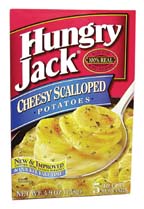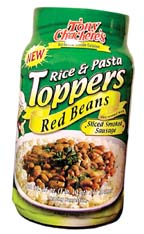
Despite racking up almost $2.3 billion in sales in 2003, the side dish category continues to see only moderate growth. In a new report on “Side Dishes,” Mintel International Group (Chicago) attributes the category's performance to aging product lines and a lack of interest by larger suppliers. As a result, small, private companies produce many of the leading side dishes.
Mintel found a smaller, private company responsible for the category's greatest increases from 2000 to 2002. Bush Brothers (Knoxville, Tenn.) witnessed sales growth of nearly 20% over the period. Savvy advertising, regional expansion and product introductions fueled the growth rate, which was almost 10 times the rate of increase of the category as a whole.
Unilever's side dish sales grew 8% in that time frame due, in large part, to its introduction of Ragu Express in the pasta and sauce segment. The side dish that some have taken to eating as a meal garnered $20 million in sales in 2002, the year after its launch. In spite of that success, the pasta and sauce segment, as a whole, lost sales for the period.
Such was not the story for baked beans and potato products, with each posting notable increases. However, significant, long-standing declines in plain rice led to the dismal overall performance of the category. As Mintel notes, “Few new innovative products (are) bucking the trend of slow decline for the category as a whole.”
Plain rice leaders suffered the steepest losses, with products from Mars (Hackettstown, N.J.), Riviana Foods (Houston) and Kraft (Glenview, Ill.) enduring a steady loss of consumer interest. Other market leaders in the segment posted unimpressive results, also, noting sales declines even in current dollars from 2000 to 2002. For many of the industry's major companies, side dishes serve as a secondary market, paving the way for smaller private companies such as Bush Brothers and Zatarain's (Gretna, La.) to achieve success by devoting far more attention to their respective segments.
Most side dish products are considered easy and quick to make, but consumers do not perceive them as new and exciting. Many simply have not been updated to match current consumer preferences or cooking styles. And, many first were introduced before the 1980s and reflect the trends of the time—mild flavorings, soft textures and limited use of herbs or spices.
Since the 1980s, Baby Boomers have sought new flavors, and manufacturers responded with Americanized versions of Asian, Italian and Mexican foods. The increasing popularity of ethnic cuisines and bolder, more flavorful products could prove a means of reviving the category. Already, a new wave of items incorporates a variety of herbs, spices and peppers, offering much stronger flavors than previously existed. Zatarain's New Orleans style rices, which feature chili pepper, cayenne pepper and a variety of hot spices, took the bolder route and saw sales jump nearly $20 million in 1999.
Also offering a new or ethnic flavor have been the Near East-Middle Eastern brands from PepsiCo (Purchase, N.Y.) and the Asian rice selections available from Unilever (Englewood Cliffs, N.J.) under its Lipton brand. Sales of rice mixes in 2003 surpassed plain rice as the largest segment of side dishes. The volume of plain rice undoubtedly was greater, but the higher price of rice mixes propelled them over the top.
Nevertheless, sales of rice mixes declined by nearly 3% in constant prices from 1998 to 2003. The declines began in 2000, fueled by the same factors negatively impacting sales of plain rice. Between 2003 and 2008, sales of rice mixes are expected to increase by 6% at current prices and decline by 6% at constant 2003 prices. Sales should be strongest in brands featuring Asian, Middle Eastern and Cajun flavors, and Mintel believes this indicates “a potential for new products that feature spices found in other popular ethnic dishes.”

The Plain, The Plain
One segment's gain is another's loss, however, and unfortunately for plain rice manufacturers, the success of rice mixes has been at the expense of their products. Sales of plain rice declined by 20% in constant prices from 1998 to 2003. Private label products led the plain rice market, slightly ahead of the 23% market share posted by Riviana.
Unfortunately, the immediate future of plain rice products does not hold much promise. Mintel believes sales will fall by 9% at current prices and by 19% at constant 2003 prices from 2003 to 2008. The decline will be the result of continually declining cooking skills and consumers' unwillingness to cook from scratch. Furthermore, flavored rice dish offerings likely will present further competition to plain rices.
Bean Better
Sales of pork and beans and baked beans were flat in constant dollars from 1998 to 2002, a fairly sad situation considering baked beans alone are the fastest-growing category of side dishes. The bright spot came from Bush Brothers' brands, which steadily introduced products, increased regional distribution and provided substantial advertising support to its products. The early 1990s saw Bush Brothers products benefiting from studies touting the positive impact of beans on health, as a low-cholesterol source of protein and fiber. Similar to rice (and for many of the same reasons, Mintel discovered), beans posted their steepest drop in 2000, due to new products in the shelf-stable aisle, such as Kraft's Stove Top Oven Classics meals.Bush Brothers' aggressive marketing efforts somewhat obscured other bean-producing companies, and may have overridden trends for the segment. If Baby Boomers continue to avoid beans, the segment could face the possibility of future declines, as their best customers (mature Americans) are replaced by generations with no habit of eating beans.
Pork and beans and baked beans are a low-cholesterol, high-protein and high-fiber food. Through emphasizing these benefits, companies could boost sales further. As is, Mintel believes total sales of pork and beans and baked beans will grow by 12% at current prices and decline by 1% at constant 2003 prices from 2003 to 2008.

Aging Pasta Mixes
Sales of pasta and sauce mixes declined 9% in constant dollars from 1998 to 2003, a result of an aging stable of products and direct competition from new meal kits. Similar to other side dishes, sales dropped drastically in 2000. That year saw a number of new meal kits introduced, supported by massive advertising campaigns that helped lure many regular users of pasta mixes.Since that year, a few new pasta mixes have launched, but most leading brands have not changed significantly in decades, and do not meet today's lifestyle needs. Many of the category's leading items were intended as a side dish for a traditional meal, appropriately enough. One of the more-successful new products, however, is more of a snack. Further differentiating Unilever's Ragu Express is that it is prepared in the microwave, has an Italian (rather than American) flavor and can be eaten directly out of its package.
Mintel notes two other introductions that also could serve as examples of innovative thinking in pasta mixes. Unilever's Lipton Asian Side Dishes is a new variation on the traditional theme, offering a regular noodle kit but with an ethnic flavor. The other is from General Mills (Minneapolis). The Betty Crocker Suddenly Salad occupies an otherwise open niche, with few competitors.
Similar to rice mixes, pasta mixes are expected to benefit from a wider range of flavors, while the success of Ragu Express and Kraft's It's Pasta Anytime! may acclimate consumers to shelf-stable pastas that require only microwaving. Nonetheless, total sales are predicted to grow 2% at current prices and decline 10% at constant 2003 prices from 2003 to 2008, as this segment “has seen less new product development and is facing increasing competition from pasta meal kits and shelf-stable pasta meals.”
Potato Heads Up
One of the bright spots in the side dish category, sales at constant prices of instant potatoes have increased over 4% from 1998 to 2003, but the true growth has been in the last couple of years. Sales grew almost 4% in 2002 and over 2% in 2003. Now available in stand-up pouches, the products also prominently promote microwave use.Mintel believes the transition from Pillsbury (Minneapolis) to International Multifoods (Minnetonka, Minn.) may have “impeded” sales of Hungry Jack, Idaho Spuds and related brands. However, the category boasts a number of items that require baking, a practice in decline in the U.S. Furthermore, certain products in the category (notably instant mashed potatoes, notes Mintel), may be perceived as old-fashioned. Plus, shelf-stable potato products face competition from frozen potato products, which are used in 62% of households, according to Simmons (New York).
Packaged instant potatoes may have a bright future, considering younger households are slightly more likely to use the fast and easy-to-prepare products. Mintel believes sales of packaged potato mixes will increase by 14% at current prices and by 1% at constant 2003 prices through 2008, with Betty Crocker's new microwaveable mashed potatoes likely to create new interest in the segment.
As a whole, total side dish sales are predicted to increase by 4% at current prices and decline by 8% at constant 2003 prices through 2008. Mintel believes food giants involved in the category will either turn more attention to it, or sell off their holdings in what they consider an ancillary market. Any new owners likely will implement a more aggressive approach, which could benefit the overall market by increasing the consumer base.
For more information on the report mentioned in this article, “The U.S. Side Dishes Market,” contact Mintel International Group Ltd.; 213 W. Institute Place, Suite 208; Chicago, IL 60610; phone: 312-932-0400.
Website Resources:
www.mintel.com — Mintel International Groupwww.bushbeans.com — Bush Brothers
www.carolinarice.com — Riviana Foods
www.zatarains.com — Zatarain's
